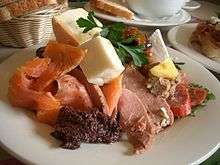Antipasto
|
Antipasto all'italiana—Italian antipasto served in a restaurant | |
| Place of origin | Italy |
|---|---|
| Main ingredients | Any of cured meats, olives, peperoncini, mushrooms, anchovies, artichoke hearts, cheese, pickled meats and vegetables (in oil or vinegar) |
| Variations | Seafood platter; calamari, mussels, smoked salmon, tuna fish, olives. |
|
| |

Antipasto (plural antipasti) means "before the meal" (from Latin ante, meaning "before", and pastus, meaning "meal, pasture"[1]), and is the traditional first course of a formal Italian meal. Traditional antipasto includes cured meats, olives, peperoncini, mushrooms, anchovies, artichoke hearts, various cheeses (such as provolone or mozzarella), pickled meats, and vegetables in oil or vinegar.
The contents of an antipasto vary greatly according to regional cuisine. It is quite possible to find different preparations of saltwater fish and traditional southern cured meats (like soppressata or 'nduja) in the south of Italy, whereas in northern Italy it will contain different kinds of cured meats and mushrooms and, especially near lakes, preparations of freshwater fish. The cheeses included also vary significantly between regions and backgrounds.
Many compare antipasto to hors d'oeuvre, but antipasto is served at the table and signifies the official beginning of the Italian meal. It may also be referred to as a starter, or an entrée.
History
Antipasti prepared with prosciutto and melon is "based upon ancient medical principles."[2]
See also
- Cured meat
- List of ancient dishes and foods
- List of hors d'oeuvre
- List of Italian dishes
- Meze
- Tapas
-
 Food portal
Food portal
References
- ↑ https://www.google.com/#q=before+in+latin; https://www.google.com/#q=food+in+latin
- ↑ Wilkins, J.; Nadeau, R. (2015). A Companion to Food in the Ancient World. Blackwell Companions to the Ancient World. Wiley. p. 11. ISBN 978-1-4051-7940-9. Retrieved May 19, 2016.
- Scicolone, Michele (1998). The Antipasto Table. HarperCollins. Retrieved April 20, 2012. ISBN 0880016272
